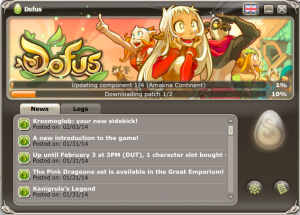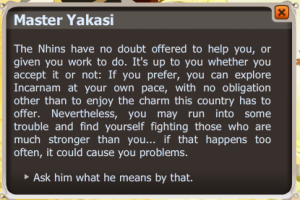For my library school class on Maker Spaces, we were given the following assignment:
Spend at least three hours (not necessarily consecutively) playing a game you were previously unfamiliar with. Analyze your gaming experience, your learning curve, what skills you learned, and whether this game could be used in a library setting.
The games I play tend to fall into two categories: puzzle games on my own (e.g., Tetris, Bejeweled) and board/card games with friends (e.g., Dominion, Agricola, Race for the Galaxy, Galaxy Trucker). For this assignment, I decided to play a game from the MMORPG genre, which is something I’ve heard about but never tried myself.
I was first tempted to try the mother of all MMORPGs, World of Warcraft. However, the free download demanded 23 GB of disk space, which I didn’t have. I therefore downloaded a game called Dofus in which the goal is to quest through the land and (eventually) find a number of dragon eggs.

The game began by putting me into a starting Tutorial mode, which was very welcome since I had no experience with this kind of interface. A man with an eagle’s head (Master Yakasi) told me to go to the next screen (area of the map) and read a story that was inscribed on a stone pillar. I returned to him and he told me to go out and speak to three particular characters. And so on. This process introduced me to the idea of quests and how to interact with my inventory as I collected new items and accomplishments. I continued playing and gained more knowledge of the game, more experience points, and more skills (e.g., I acquired the profession of Farming and learned how to wield a scythe to reap wheat). I also learned how to engage in combat, and I killed a Moskito and an Arachnoid. I found several monuments and read about them (sadly, the writing quality is not very good; it may be translated from a non-English original language). The graphics are quite attractive and often very detailed (down to cups and plates that are only a few pixels in size).
I enjoyed the exploration part of the game, moving from scene to scene. Although there are quests you can take on, the game explicitly noted that you are not obligated to do so. There is no obvious competitive element, so you are free to decide what objectives matter the most to you (Experience points? Exploration? Completing quests? Gaining new skills?).

Over the course of three hours, I was able to rise to level 7 in experience points. I don’t have enough context to judge what that means (a lot? a little?).
 The game does tell you how many experience points you have and how many you need to reach the next level, so you can seek out ways to gain those points and advance. One feedback element I really liked is that the game tells you when you aren’t ready for something that you attempt to do. For example, I found a hot-air balloon and was offered the option of riding it to a different part of the game world. I agreed, but then was told that I had not progressed enough to go there and that I should spend more time exploring first. This is great feedback since it prevented me from inadvertently taking on problems (or monsters) that I would be unable to defeat. The game is structured as a series of quests, and they are broken into steps you can consult so you know what you need to do next (e.g., “Talk to Brett Ernal” or “Take 6 Wheat to Piwi”). However, it was unclear to me whether they actually progress in difficulty. The quests are split into two categories: “Main Game” and “Incarnum,” which suggests to me that the Main Game ones matter for the general narrative and the others are optional side-quests to gain experience points or resources.
The game does tell you how many experience points you have and how many you need to reach the next level, so you can seek out ways to gain those points and advance. One feedback element I really liked is that the game tells you when you aren’t ready for something that you attempt to do. For example, I found a hot-air balloon and was offered the option of riding it to a different part of the game world. I agreed, but then was told that I had not progressed enough to go there and that I should spend more time exploring first. This is great feedback since it prevented me from inadvertently taking on problems (or monsters) that I would be unable to defeat. The game is structured as a series of quests, and they are broken into steps you can consult so you know what you need to do next (e.g., “Talk to Brett Ernal” or “Take 6 Wheat to Piwi”). However, it was unclear to me whether they actually progress in difficulty. The quests are split into two categories: “Main Game” and “Incarnum,” which suggests to me that the Main Game ones matter for the general narrative and the others are optional side-quests to gain experience points or resources.
One game aspect that I looked forward to exploring, since Dofus is an MMORPG, was the interaction with other players. The first real player (as opposed to game character) that I encountered was Babygurl, who ignored my tentative “Hi there!” Next I discovered Dark-Kirito, who responded with “hey” and then invited me to join his “group.” I had no idea what that meant, but I accepted. His group consisted of the two of us and Babygurl. At that point I realized that they were levels 27 and 23, respectively, so at level 7 I was definitely a newbie. Here is our conversation:
Me: Hi, I’m new to the game.
Dark-Kirito: lol really.
I was so embarrassed that I went silent for a while, then ventured “What’s your current goal?” which neither of them answered. Meanwhile, the game continued to flood me with details about the battles they were engaging in (at other locations on the map). I tried to join them at those locations and see if I could help, but in each case the battle was over before I made it there. Perhaps the game would benefit from more guidance about how to interact with other players.
I also expected that an MMORPG would provide more opportunity for role-playing. However, interactions with the in-game characters were limited to a choice of two (sometimes only one) pre-written text response(s) to their comments. There was not much opportunity that I observed for acting out your character’s personality, story, and style.
Yet this game has accumulated a devoted following. There are players who create Dofus fan art, post Dofus fan art to Pinterest, post videos of their game play, and more.
I found Dofus to be an interesting world to explore, and no doubt with more time invested I would discover more elements of interest and create more substantial connections to other players.



 William Spaniel offers an interesting alternative metaphor. He
William Spaniel offers an interesting alternative metaphor. He 

